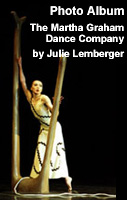|
|
the
New York manufacturer of fine dance apparel for women and girls. Click
here to see a sample of our products and a list of web sites for purchasing.
With Body Wrappers it's always performance
at its best.
|
Go
back to Flash Reviews
Go
Home
Flash Review, 12-12: Preljocaj's
'Rite'
The Hazards of Art by Commission
By Paul Ben-Itzak
Copyright 2001 The Dance Insider
PARIS -- For years, presenters have
been urging the leading French choreographer Angelin Preljocaj to tackle "Le Sacre
du Printemps(Rite of Spring)," the Igor Stravinsky music first made into an infamous
ballet by Vaslav Nijinsky. Preljocaj, as humble in his personal manner as he is
daring in his subject matter, resisted -- until he got an offer he couldn't refuse
from the respected musician and conductor Daniel Barenboim, director of the Berlin
Staatsopera. Once he committed to the project, presenter money poured in from
all over the world, including the National Endowment for the Arts. The result,
which received its Paris premiere at the Theatre de la Ville-Sarah Bernhardt last
night after premiering in Berlin this spring, is certainly no failure. But in
Preljocaj's admirable approach -- except for modern dancey costumes, he stuck
to the original story of a primitive society and its virgin sacrifice, rather
than spinning it off radically -- the only real new revelation in this production
by Ballet Preljocaj is that calls from presenters can't take the place of calls
from the Muse.
Most of you know the history of this
monumental 20th century work, but for those who don't: At the 1913 premiere, fist-fights
broke out in the audience at the Theatre des Champs Elysees. To tell the story
of a primitive people, in a plot hinging on a sacrifice of "the chosen one," Nijinsky
-- influenced by Eurythmics -- devised a jerkey movement whose most sacreligious
element was the turned in feet of the dancers. As John Percival writes in "The
World of Diaghilev":
"The dancers with their toes turned
in, their heads leaning sideways to be propped up by one arm, itself supported
on the other fist, made an unusual site....The ballet was received at its first
performance with shouts of derision and whistles, making it difficult for the
dancers to hear the music."
Even if his contemporary Michel Fokine
may have actually done more to push ballet into the 20th century informed by a
modern sensibility, for shock value Nijinsky's "Rite" was unparalleled.
While no one in dance today occupies
a place comparable to Nijinsky, in France Angelin Preljocaj might be said to occupy
the highest niche which was once occupied by Nijinsky. By virtue of both funding
from the French government and bookings from American presenters (with U.S. tax
dollars), he is now, one might say, the officially approved radical French choreographer.
This bourgeoisie acceptability has created the requisite backlash in the current
underground French dance scene, where it's common for young dancers and choreographers
to snear or shrug at the mention of his name.
I don't think all of Preljocaj's
creations succeed, particularly his entry in last Spring's
France Moves festival in NYC. But, I think he's an honest choreographer with unquestioned
integrity. Where he has failures or near misses, they are noble ones, and I think
we need to permit the artists we love to break from the mold we love, even if
it's to go in directions that make us cringe. And I think his integrity saves
him. Is it a sacrilege to cut up the score of Prokoviev's "Romeo & Juliet," as
Preljocaj did for his production? Probably. But if the re-cast result is a "Romeo
& Juliet" which addresses -- and helps us better understand -- our Bosnias, can
we condone the changes to the score? Probably.
But in his "Romeo & Juliet," Preljocaj,
whose parents are from Albania, found a personal story to tell. Ditto in "Annonciation,"
(in my reading) a very personal tale of two women, one a teacher, one a sort of
virgin, which is transforming because of the way the two women affect and change
each other. I don't know exactly what the story was, but I know it was one that
moved the choreographer and it moved me.
Preljocaj's "Sacre du Printemps"
doesn't resonate in quite this way. Here, unlike his R&J;, the modernization goes
only so far as the employment of modern dance gestures, not the building of a
new contemporary narrative. And those gestures -- the tossings of women by men,
hitting of women by men, humping of women by men, the weaving of one under the
other, the men nonchalantly watching in their bright pastel button-down shirts
as the women slide their underwear to their ankles, then toss it off, then repeat
this motion several times in the first section -- while they might work for a
more intimate story, come off as mundane when trying to express music of such
bombast.
As they watch, the men are reclining
on pods of turf which later are combined into what is supposed to be the sacrificial
ground for Nadine Comminges's Chosen One, but which has a striking resemblance
to a golf sandpit. Scaling that sandpit naked as she tries to escape, only to
be tossed back by the others, Nadine Comminges comes awfully close to lifting
this "Rite" to an epic scale; waifish with a shock of brown-red hair, an expression
of openness to the world, Comminges projects the same vulnerability and yet tireless
spirit which created empathy for her Juliet. But other passages fall woefully
short -- indeed are almost the opposite in their tempo from the epochal sweep
of the music, as when the women, watching the men dance from the pods, smile in
light amusement.
Nijinsky doesn't own "Rite of Spring,"
and so other choreographers have a right to try their hands at it. And it would
be unfair to ask them to create a vocabulary for the ballet which shocks on the
level of the original. BUT, I think without something original -- physically --
to add to it, they can only disappoint. Preljocaj's strength, I think, is not
so much in the originality of his movement but in his personal investment in all
his dance stories. All his ballets -- even the one I didn't care off -- play as
if the choreographer is grabbing you by the shoulders, shaking you, and saying,
"You must listen to my story." The choreography is simply a channel for his stories,
and for the emotions they produce in both the performers and us. In approaching
"Le Sacre du Printemps," Preljocaj has tried to apply his choreography to someone
else's message. The result certainly matches the music, but I don't know that
it reveals anything new in the story. Writers or choreographers, our stories need
to come from within. Or, at least, if we're telling someone else's story, there
needs to be something in it to which we can apply our personal vision. Preljocaj
has certainly created choreography that matches the music, but I don't know that
he has found anything in the music that speaks to him, and thus created anything
that speaks to us a story we haven't already heard from this music and the original
ballet.
Once can't really fault the presenters
for wanting to coax Preljocaj into trying his hand at "Rite of Spring." On its
face, it seems like a natural match. Indeed a dream match. And I must admit that
watching a new dance to this music, I thought to myself, "Hey, wouldn't it be
cool to see what Mark Dendy and Larry Keigwin could do with this music? Maybe
I'll write Mark and suggest it!"
But the result here -- unsurprising
movement from one of our most wrenching and chilling choreographers -- reminds
me that presenters, like journalists, aren't artists, and should resist the temptation
to tell artists where to put their paintbrushes. They are, ideally, tasteful arbiters
of talent, and maybe it should be enough that they simply say, either, "We like
you as an artist. Here's some money. Go create something," or, "Let me see your
latest creation, and if I like it, we'll present it."
Of course, in the case of Preljocaj,
they might find themselves saddled with the musically assaulting and physically
repetitive "Helikopter," which opened last night's program. It's exactly what
it sounds like -- dance to music on the theme of a helicopter -- and it was rather
dumb, musically speaking, to pair this with "Rite of Spring." Dissonance may not
be melodious, but it has its harmony; it may not always be "pleasing" to the ear,
but it stimulates. "Helikopter" composer Karlheinz Stockhausen doesn't seem to
understand this, a fact of which this piece's being followed by the Stravinsky
reminded us of. What he gave us was just noise, and, while it might be an interesting
laboratory idea to see how many movements you can come up with that mimic the
helicopter, after a few whirlings and twirlings I started yawning.
Ballet Preljocaj's program of "Helikopter"
and "Le Sacre du Printemps" is performed again tonight through Saturday and next
Tuesday through Saturday, at the Theatre de la Ville-Sarah Bernhardt.
P.S. If presenters really want to
bring "Rite of Spring" to their audiences, perhaps they could consider booking
the Joffrey Ballet, which has a stunning production of the Millicent Hodson-Kenneth
Archer re-construction of the Nijinsky original. Do we really need to be paying
beaucoup U.S. tax dollars to see this work from trendy French choreographers,
when a perpetually financially -struggling American treasure, the Joffrey, is
mounting the original? (Just asking!)
Go
back to Flash Reviews
Go Home
|








